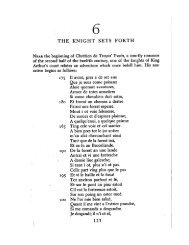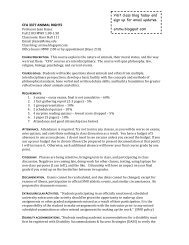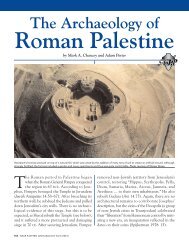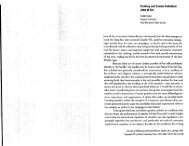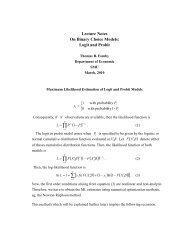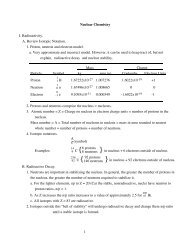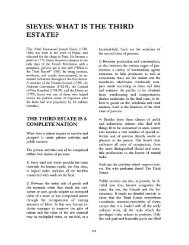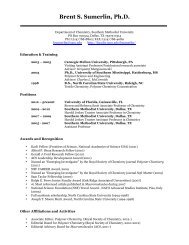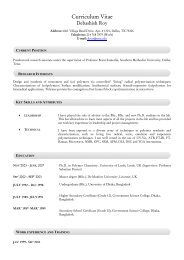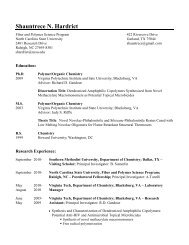Warfare and Human Sacrifice in the Inca Empire: - Smu
Warfare and Human Sacrifice in the Inca Empire: - Smu
Warfare and Human Sacrifice in the Inca Empire: - Smu
You also want an ePaper? Increase the reach of your titles
YUMPU automatically turns print PDFs into web optimized ePapers that Google loves.
(Topic 11)<br />
<strong>Warfare</strong><br />
<strong>and</strong> <strong>Human</strong><br />
<strong>Sacrifice</strong> <strong>in</strong><br />
<strong>the</strong> <strong>Inca</strong><br />
<strong>Empire</strong>:<br />
AD 1438-1532 1438 1532<br />
Quito<br />
Huánuco Hu nuco Pampa<br />
Machu Picchu<br />
Cuzco<br />
Mt. Ampato
Quito<br />
Huánuco Hu nuco Pampa<br />
Machu Picchu<br />
Cuzco<br />
Mt. Ampato<br />
Maule River
Growth of <strong>the</strong><br />
<strong>Inca</strong> <strong>Empire</strong>: <strong>the</strong><br />
Conquerors<br />
Pachacuti<br />
1438-1471<br />
Tupac <strong>Inca</strong><br />
1471-1493<br />
Huayna Capac<br />
1493-1527<br />
<strong>Inca</strong> <strong>Empire</strong><br />
Length:<br />
4300 km (2670 mi)<br />
(1,835,000 km²) km<br />
Chanca<br />
Chumpivilca<br />
Approximate<br />
orig<strong>in</strong>al area of<br />
Quechua speakers<br />
Colla<br />
(pre-AD (pre AD 1438)<br />
Cuzco<br />
Orig<strong>in</strong>s of <strong>the</strong> <strong>Inca</strong> State:<br />
POSSIBLE CAUSES:<br />
ideology (‘civiliz<strong>in</strong>g ( civiliz<strong>in</strong>g’ <strong>the</strong> Andes)?<br />
politics (split <strong>in</strong>heritance)?<br />
<strong>in</strong>itial population pressure?
Growth of <strong>the</strong><br />
<strong>Inca</strong> <strong>Empire</strong>: <strong>the</strong><br />
Conquerors<br />
Pachacuti<br />
1438-1471<br />
Tupac <strong>Inca</strong><br />
1471-1493<br />
Huayna Capac<br />
1493-1527<br />
<strong>Inca</strong> <strong>Empire</strong><br />
Length:<br />
4300 km (2670 mi)<br />
(1,835,000 km²) km<br />
Split<br />
<strong>in</strong>heritance<br />
&<br />
civiliz<strong>in</strong>g …?<br />
Chanca<br />
Chumpivilca<br />
Population pressure &<br />
civiliz<strong>in</strong>g …?<br />
Approximate<br />
orig<strong>in</strong>al area of<br />
Quechua speakers<br />
Colla<br />
(pre-AD (pre AD 1438)<br />
Cuzco<br />
Orig<strong>in</strong>s of <strong>the</strong> <strong>Inca</strong> State:<br />
POSSIBLE CAUSES:<br />
ideology (‘civiliz<strong>in</strong>g ( civiliz<strong>in</strong>g’ <strong>the</strong> Andes)?<br />
politics (split <strong>in</strong>heritance)?<br />
<strong>in</strong>itial population pressure?<br />
… RESULT:<br />
WARFARE !!!
<strong>Inca</strong> cultural diagnostics …
Sacsahuamán<br />
Sacsahuam<br />
Coricancha
Sacsahuamán<br />
Sacsahuam
Growth of <strong>the</strong><br />
<strong>Inca</strong> <strong>Empire</strong>: <strong>the</strong><br />
Conquerors<br />
Pachacuti<br />
1438-1471<br />
Tupac <strong>Inca</strong><br />
1471-1493<br />
Huayna Capac<br />
1493-1527<br />
civil Atahuallpa<br />
war Huáscar<br />
First<br />
contact<br />
between<br />
Spaniards<br />
& <strong>Inca</strong>s,<br />
AD 1532<br />
<strong>Inca</strong><br />
<strong>Empire</strong><br />
Demise<br />
of <strong>the</strong><br />
<strong>Inca</strong> State<br />
Causal factors:<br />
<strong>Inca</strong> side<br />
Spanish side<br />
Results …
Francisco Pizarro
168 Spaniards & 37 horse<br />
vs.<br />
<strong>Inca</strong> army of 30,000-60,000
<strong>Inca</strong> militarism:<br />
1. The legendary founders of <strong>the</strong> <strong>Inca</strong> state, Manco Capac <strong>and</strong> his wife,<br />
Máma ma Oqllu, <strong>and</strong> <strong>the</strong>ir followers <strong>in</strong>vaded <strong>the</strong> Cuzco area <strong>and</strong> took it<br />
over by force, assimilat<strong>in</strong>g, not kill<strong>in</strong>g off, <strong>the</strong> former <strong>in</strong>habitants<br />
<strong>in</strong>habitants<br />
(<strong>Inca</strong> wars were for conquest, not annihilation of a people).<br />
2. The strategy for mov<strong>in</strong>g <strong>the</strong> army, carry<strong>in</strong>g out conquests, <strong>and</strong><br />
<strong>in</strong>tegrat<strong>in</strong>g conquered prov<strong>in</strong>ces <strong>in</strong>to <strong>the</strong> empire <strong>in</strong>cluded: <strong>in</strong>cluded<br />
a. road system <strong>and</strong> bridges<br />
b. locat<strong>in</strong>g tambo way stations along <strong>the</strong> roads (every several km.)<br />
c. locat<strong>in</strong>g adm<strong>in</strong>istrative centers along <strong>the</strong> roads (at 4-5 4 5 day’s day<br />
travel apart)<br />
d. hierarchiz<strong>in</strong>g <strong>the</strong> army <strong>in</strong>to decimal units<br />
(5,10,50,100, 500,1000, 5000,etc.)<br />
e. send<strong>in</strong>g out spies to ga<strong>the</strong>r <strong>in</strong>telligence <strong>in</strong> advance of <strong>the</strong> army
3. Conquests of prov<strong>in</strong>ces were not def<strong>in</strong>itive: <strong>the</strong> <strong>Inca</strong> had to take tak<br />
strategic measures to keep <strong>the</strong>m under control—<strong>in</strong>clud<strong>in</strong>g<br />
control <strong>in</strong>clud<strong>in</strong>g:<br />
a. mitimaes<br />
b. <strong>in</strong>corporat<strong>in</strong>g local chiefs (curacas) <strong>in</strong>to <strong>the</strong> state hierarchy<br />
c. tak<strong>in</strong>g chiefs’ chiefs sons hostage to Cuzco<br />
d. tak<strong>in</strong>g local ‘idols, idols,’ or gods, hostage to Cuzco<br />
e. admitt<strong>in</strong>g chiefs’ chiefs daughters to <strong>the</strong> Houses of <strong>the</strong> Chosen Women<br />
(Acllahuasi) whereupon <strong>the</strong>y became part of <strong>the</strong> <strong>Inca</strong> cult of <strong>the</strong><br />
Sun God, Inti<br />
4. Imperial “taxation taxation” policy: policy<br />
a. prov<strong>in</strong>cial men <strong>and</strong> women owed labor service (mit’a) (mit a) to <strong>the</strong><br />
state—men state men both to <strong>the</strong> army <strong>and</strong> state l<strong>and</strong>s <strong>and</strong> projects,<br />
women to state l<strong>and</strong>s <strong>and</strong> projects<br />
b. citizens owed allegiance to <strong>the</strong> state cult of <strong>the</strong> Sun God<br />
c. prov<strong>in</strong>ces were required to offer adolescent males <strong>and</strong> females<br />
as Capacocha (Capa Cocha) to <strong>the</strong> empire for sacrifice
5. Organization of <strong>the</strong> army: army<br />
a. every able-bodied able bodied man under 30 was subject to conscription<br />
b. younger men (age 10-18) 10 18) were drilled <strong>in</strong> <strong>the</strong> use of Andean<br />
weapons<br />
c. on <strong>the</strong> march, soldiers were not permitted to pillage or abuse<br />
local people<br />
d. each tribal (prov<strong>in</strong>cial) group was permitted to use its own dress dress<br />
<strong>and</strong> <strong>in</strong>signias<br />
e. desertion was a capital crime<br />
6. Div<strong>in</strong>ation was carried out by <strong>the</strong> priests to foretell outcome of a<br />
military campaign: campaign<br />
a. ‘read<strong>in</strong>g read<strong>in</strong>g’ <strong>the</strong> signs on <strong>the</strong> entrails of llamas<br />
b. also, maize kernels—seen, kernels seen, it seems, as ‘little little people’—were<br />
people were<br />
placed <strong>in</strong> a bowl over a fire by a div<strong>in</strong>er, who by nudg<strong>in</strong>g <strong>the</strong>m<br />
with a little rod forced <strong>the</strong>m to do what he wanted (“<strong>the</strong> <strong>the</strong><br />
gra<strong>in</strong>s <strong>the</strong>n had a great fight, some aga<strong>in</strong>st o<strong>the</strong>rs, until <strong>the</strong> <strong>the</strong><br />
conquered were driven out of <strong>the</strong> vessel”); vessel ); this procedure<br />
guaranteed success of <strong>the</strong> campaign.
“In comparison to <strong>the</strong> horses <strong>and</strong> weapons of <strong>the</strong> Spanish,<br />
<strong>the</strong> <strong>Inca</strong> army was poorly equipped. But <strong>in</strong> Andean terms<br />
this was a very impressive fight<strong>in</strong>g body.”<br />
Source: www.soltec.net/~rusk<strong>in</strong>/Meet_<strong>the</strong>_<strong>Inca</strong>s/
Weapons <strong>in</strong>cluded:<br />
braided sl<strong>in</strong>gs for hurl<strong>in</strong>g stones<br />
bolas<br />
thrust<strong>in</strong>g spears<br />
spear throwers <strong>and</strong> darts<br />
swords of hard chonta wood<br />
maces<br />
Protective gear <strong>in</strong>cluded:<br />
quilted cotton tunics<br />
round metal plates on chest <strong>and</strong> back<br />
quilted or wood helmets<br />
shields made of chonta palm covered<br />
with deersk<strong>in</strong> or textile
ECUADOR<br />
COLOMBIA<br />
PERU<br />
(NASA photo of <strong>the</strong> Central Andes)<br />
CHILE<br />
BRAZIL<br />
BOLIVIA<br />
(area of photo)<br />
<strong>Inca</strong> Road<br />
System:<br />
23,000 km.<br />
Ma<strong>in</strong> sierra<br />
road:<br />
4000+ km<br />
Capac<br />
Ñan an
Ingapirca (Cuenca)<br />
Ingapirca, Ecuador
“El primer nueva<br />
corónica y buen<br />
gobierno conpuesto<br />
por don Phelipe<br />
Gvaman Poma<br />
De Aiala”<br />
[~AD 1615]
Guaman Poma de Ayala <strong>and</strong> parents The author sets out out<br />
on his travels
organization of <strong>the</strong> empire …<br />
Aqllacuna ‘monjas monjas’ (chosen women) The governor of <strong>the</strong> imperial bridges bridges
organization of <strong>the</strong> empire …<br />
“CO CONTADOR MAYOR Y TESORERO” “CORREÓN MAYOR Y MENOR”<br />
Contador (accountant) with quipu str<strong>in</strong>gs Chasqui runner blow<strong>in</strong>g conch shell
Punishment of death by ston<strong>in</strong>g<br />
for an adulterous couple<br />
imperial laws …<br />
Punishment of death for a young<br />
couple that has fornicated
ocks?<br />
idol<br />
The seventh capta<strong>in</strong>, <strong>Inca</strong> Maytoc,<br />
attacks a fort <strong>in</strong> <strong>the</strong> Bolivian prov<strong>in</strong>ces<br />
war <strong>in</strong> <strong>the</strong> south …<br />
“Indios Indios de Chile” Chile<br />
The eighth capta<strong>in</strong>, Abo Camac <strong>Inca</strong>,<br />
fights an army from Chile
The tenth capta<strong>in</strong>, Chalco Chima <strong>Inca</strong>,<br />
fights <strong>in</strong> Quito <strong>and</strong> o<strong>the</strong>r nor<strong>the</strong>rn areas<br />
war <strong>in</strong> <strong>the</strong> north …<br />
The eleventh capta<strong>in</strong>, Rumi Naui, a<br />
traitor, kills <strong>Inca</strong> Illescas <strong>in</strong> Quito
The n<strong>in</strong>th <strong>Inca</strong>, Pachacuteq <strong>Inca</strong>,<br />
dressed for battle<br />
emperors <strong>and</strong> capta<strong>in</strong>s <strong>in</strong> war …<br />
A war leader hold<strong>in</strong>g <strong>the</strong><br />
severed head of an enemy
Growth of <strong>the</strong><br />
<strong>Inca</strong> <strong>Empire</strong>: <strong>the</strong><br />
Conquerors<br />
Pachacuti<br />
1438-1471<br />
Tupac <strong>Inca</strong><br />
1471-1493<br />
Huayna Capac<br />
1493-1527<br />
Chanca<br />
Chumpivilca<br />
Cuzco<br />
Colla<br />
<strong>Inca</strong><br />
<strong>Empire</strong>
Paracas &<br />
Nazca, ca.<br />
1000 B.C.<br />
to A.D. 500<br />
Casma Valley,<br />
ca. 1500 B.C.
Body of Huayna Capac (d. 1528)<br />
is taken to Cuzco<br />
The arrival of <strong>the</strong> Spaniards …<br />
“donzellas donzellas presenta a los cristianos” cristianos<br />
Rumi Naui presents two <strong>Inca</strong> girls to<br />
Pizarro, try<strong>in</strong>g to get him to leave Peru
Pizarro attacks Atahuallpa<br />
<strong>in</strong> Cajamarca<br />
Spaniards vs. Atahuallpa …<br />
The Spaniards execute<br />
Atahuallpa
Spanish capta<strong>in</strong> kills an <strong>Inca</strong><br />
<strong>in</strong> <strong>the</strong> conquest of Lima<br />
Spaniards vs. <strong>Inca</strong> citizenry …<br />
Pizarro sets an <strong>in</strong>digenous<br />
house <strong>in</strong> Lima on fire
Santa María Mar a appears dur<strong>in</strong>g a<br />
battle <strong>and</strong> scares off <strong>the</strong> <strong>Inca</strong> soldiers<br />
a little help from <strong>the</strong> Spanish deities …<br />
“MILAGRO MILAGRO”<br />
St. Santiago appears <strong>in</strong> battle<br />
to help <strong>the</strong> Spaniards
Diego de Almagro, of <strong>the</strong> same<br />
name as his fa<strong>the</strong>r, kills Pizarro<br />
Spaniard vs. Spaniard …<br />
Gonzalo Pizarro, bro<strong>the</strong>r of <strong>the</strong><br />
conqueror, kills Diego de Almagro
Urubamba canyon en route to Machu Picchu
1-meter meter ridge …<br />
1-bounce bounce slope down… down<br />
1-hour hour slope up …<br />
2000 ft.<br />
wider slop<strong>in</strong>g ridge
1-meter meter ridge …<br />
1-bounce bounce slope down… down
B<strong>and</strong>-level B<strong>and</strong> level ‘defensive defensive’ works Village-level Village level palisaded settlement<br />
(gender relations: essentially non-violent)<br />
non violent) (gender relations: violent)
gender relations …?<br />
fort<br />
dwell<strong>in</strong>gs<br />
of<br />
‘commoners commoners’<br />
Chiefdom society fort <strong>and</strong> settlement, Santa Valley
(gender relations: essentially non-violent)<br />
non violent)<br />
<strong>Inca</strong> State
<strong>Inca</strong><br />
Capacocha<br />
Cuzco<br />
Nevado Ampato<br />
Volcán Volc n Llullaillaco<br />
Cerro Plomo
Cerro Plomo, Chile<br />
Life magaz<strong>in</strong>e, April 5, 1954
Cerro Plomo
(Volcán (Volc n Llullaillaco)
Volcán Volc n Llullaillaco,<br />
Argent<strong>in</strong>a
Nevado Ampato, <strong>and</strong> Juanita, ‘<strong>the</strong> <strong>the</strong> ice maiden’<br />
maiden
Spondylus shell<br />
(Ecuador)
Detail of vessel shown upper left.<br />
Pumice fused to <strong>the</strong> h<strong>and</strong>le shows<br />
it was struck by lightn<strong>in</strong>g after <strong>the</strong><br />
burial was sealed.
fracture
(from Time<br />
magaz<strong>in</strong>e<br />
June 3, 1996)
“I’ll ll take <strong>the</strong> fifth<br />
on that one!” one!<br />
“Heh, Heh, heh …<br />
just wait till<br />
we get home, Bob!”<br />
Bob!
“…or, “…or,<br />
Monica,<br />
will you be<br />
my mummy?” mummy?<br />
“Bill, Bill, don’t don t make<br />
me hurt you!”<br />
you!
Andeans & <strong>Inca</strong><br />
<strong>Sacrifice</strong> as a religious &<br />
ideological <strong>in</strong>dication of<br />
demographic pressure …<br />
(Bernab Bernabé Cobo, Cobo,<br />
<strong>Inca</strong> Religion<br />
<strong>and</strong> Customs, ~1653: ~1653:<br />
… llamas were sacrificed to ensure<br />
<strong>the</strong> health <strong>and</strong> well-be<strong>in</strong>g well be<strong>in</strong>g of<br />
humans, <strong>and</strong> to <strong>the</strong> Sun God, Inti<br />
vs.



